Blog, Industry News, trenchless products
 Truck vacs offer power, scalable tank capacity and reliability for high-production contractors
Truck vacs offer power, scalable tank capacity and reliability for high-production contractors
GREENVILLE, S.C. — June 7, 2017 — McLaughlin has extended its Vermeer MEGA VAC vacuum excavator product line with new PTO-driven options. The Vermeer VXT truck series was developed in response to industry requests for a productive vacuum excavator that meets weight regulations and that is backed by the support of the Vermeer dealer network.
Ideal for utility and distribution contractors, the VXT Series is a reliable, cost-effective solution for high-production potholing crews. The new MEGA VAC PTO-driven vacuum excavators come in three standard spoil capacity options: the VXT6 (6-yard), the VXT8 (8-yard), and the VXT10 (10-yard).
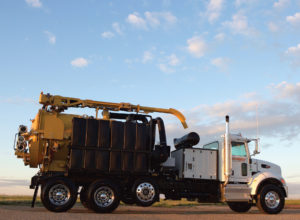 “The new VXT truck series is designed for the production-minded utility contractor who is focused on maximizing uptime and maintaining a safe and productive jobsite,” said Jeff Wage, vice president at McLaughlin. “These machines fit that niche of being able to do the work that’s required at a price point high-production contractors can justify.”
“The new VXT truck series is designed for the production-minded utility contractor who is focused on maximizing uptime and maintaining a safe and productive jobsite,” said Jeff Wage, vice president at McLaughlin. “These machines fit that niche of being able to do the work that’s required at a price point high-production contractors can justify.”
Proven for potholing
The VXT series is a 6-inch (15.2 cm) system featuring spoil tank capacities ranging from 1,200 to 2,000 gallons (4542.5 to 7570.8 L) and a standard option of 800 gallons (3028.3 L) of fresh water. For off-road applications, larger spoil tank capacities are available from 2,200, 2,600 and 3,000 gallons (8327.9, 9842.1 and 11,356.2 L).
“Contractors asked for a 6-inch vacuum excavator for potholing performance and the ability to work in certain rocky and granular ground conditions,” said Wage.
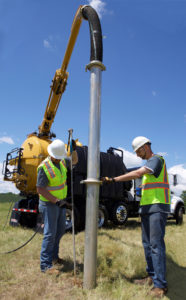 The VXT Series is powered by the industry-proven OMSI Gearbox and a ROOTS 3200 CFM (91 m3/min) blower. When the truck is put into PTO mode, the rear axle is disengaged and the OMSI gearbox becomes live to drive the ROOTS blower at 18 inches of mercury and 3200 cfm. The OMSI gearbox hydraulically provides the power to drive the 10 gpm/3,000 psi water pump as well.
The VXT Series is powered by the industry-proven OMSI Gearbox and a ROOTS 3200 CFM (91 m3/min) blower. When the truck is put into PTO mode, the rear axle is disengaged and the OMSI gearbox becomes live to drive the ROOTS blower at 18 inches of mercury and 3200 cfm. The OMSI gearbox hydraulically provides the power to drive the 10 gpm/3,000 psi water pump as well.
The new CAN Control system allows for two-way communication between the remote control and the vacuum excavator. With the CAN Control system operators can start the MEGA VAC, control the idle speed, dump spoils, open the rear door and control full boom operation, which helps contractors increase jobsite productivity. The controls also give a full readout on performance of the engine, the blower and the water pump.
The new Vacuum Neutral feature adds to operator safety and productivity on the jobsite. In Vacuum Neutral mode, the blower breathes free air and stops suction without the need to close the hydraulic gate valve in the boom. This allows an operator to work safely near the boom without having to shut the vacuum off.
Capacity that will scale
Utility contractors, gas distribution contractors and the large contractors building fiber optic networks must balance the need for maximum spoil tank capacity with increasingly stringent weight regulations and restrictions. The VXT6 and the VXT8 MEGA VACs were designed with scalability as a top priority. Built on a 10-wheel Peterbilt chassis, the VXT6 has a 1,200-gallon (4542.4 L) spoil tank capacity and can carry up to 410 gallons (1552 L) of water and still meet weight regulations. The VXT8 has a 1,600-gallon (6056.7 L) tank capacity and can carry up to 800 gallons (3028.3 L) of fresh water. With a standard drop axle, the VXT8 weighs only 33,000 pounds (14,968.5 kg) empty on the Peterbilt 348 chassis.
“Time and time again, we hear concerns from contractors regarding overweight vehicles on the highway. Allowing units to run overweight puts both their employees and their company at risk for financial and legal repercussions,” said Wage. “By selecting the VXT6 or the VXT8, a contractor can reduce the risks and improve working conditions for their employees.”
For reassurance that the vacuum meets weight regulations, the VXT Series features the new optional Air-Weigh scale system. Incorporated into the chassis and the CAN Controls, the Air-Weigh scale system informs the operator when a truck hits its preprogrammed maximum axle weights. At the point that the truck reaches a preprogramed axle capacity, the unit will automatically enter Vacuum Neutral mode. The control panel message will allow the operator to “override” the Vacuum Neutral mode or can be programed with a security code so only a manager may authorize a system override.
All McLaughlin vacuum excavators are backed by the Vermeer dealer network. The worldwide dealer network means consistent parts availability and a knowledgeable staff wherever the job takes contractors. To learn more, visit mclaughlinunderground.com or email McLaughlin at mmole@mightymole.com.
Blog, Industry News, trenchless projects
Ceremony with Georgian Prime Minister commissions Green Power Station
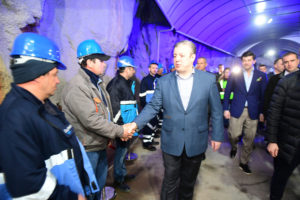 In April 2017, a ceremony was held to celebrate the commissioning of the Dariali Hydropower Project in the Republic of Georgia. Many attended the ceremony marking the first carbon-neutral hydropower project in the world, including Georgian Prime Minister, Giorgi Kvirikashvili. The power station, an independent power project (IPP) developed through Dariali Energy Ltd, was a joint venture involving three other firms: Georgian private companies Peri Ltd and Energy LLC, and state-owned Georgian Energy Development Fund (GEDF). The Dariali HPP gathers water from the Tergi River and directs it through the headrace tunnel to the power house located near the Russian—Georgian border. Each year, the site will generate 500 GWhs of carbon-neutral energy, with 70 percent of power production occurring during the country’s summer months.
In April 2017, a ceremony was held to celebrate the commissioning of the Dariali Hydropower Project in the Republic of Georgia. Many attended the ceremony marking the first carbon-neutral hydropower project in the world, including Georgian Prime Minister, Giorgi Kvirikashvili. The power station, an independent power project (IPP) developed through Dariali Energy Ltd, was a joint venture involving three other firms: Georgian private companies Peri Ltd and Energy LLC, and state-owned Georgian Energy Development Fund (GEDF). The Dariali HPP gathers water from the Tergi River and directs it through the headrace tunnel to the power house located near the Russian—Georgian border. Each year, the site will generate 500 GWhs of carbon-neutral energy, with 70 percent of power production occurring during the country’s summer months.
Robbins also invested in the project by gaining equity through supplying tunneling equipment and services in consortium with contractor Peri. “Robbins understood the risk in the tunneling portion of the project and we were compensated for taking on part of the risk. Peri is a long-time customer, as we supplied a TBM to them 15 years ago for a small project in Georgia. It was great to be invited to invest and risk share on this project, and to work together again,” said Robbins President Lok Home. The 5 km (3 mi) long headrace tunnel for the power station was bored with the use of a 5.5 m (18 ft) diameter Robbins Main Beam TBM starting in February 2012.
 Due to the remote and mountainous location of the jobsite 160 km (100 mi) from the capital Tbilisi, the machine was shipped in pieces to contractor Peri’s workshop, where they were refurbished under Robbins supervision and then delivered to the site to be assembled. Each piece was transported by truck down narrow, winding roads that eventually gave way to dirt paths. Assembly at the jobsite was difficult, as the project site at a 1,700 m (1.0 mi) altitude was blanketed in snow and components arrived in December. Bone-chilling temperatures often reached negative 15 degrees Celsius (5ºF), and 40 below with the wind chill factor. Once the machine had launched, it encountered difficult ground including slate, sandstone, limestone and malms with fault zones.
Due to the remote and mountainous location of the jobsite 160 km (100 mi) from the capital Tbilisi, the machine was shipped in pieces to contractor Peri’s workshop, where they were refurbished under Robbins supervision and then delivered to the site to be assembled. Each piece was transported by truck down narrow, winding roads that eventually gave way to dirt paths. Assembly at the jobsite was difficult, as the project site at a 1,700 m (1.0 mi) altitude was blanketed in snow and components arrived in December. Bone-chilling temperatures often reached negative 15 degrees Celsius (5ºF), and 40 below with the wind chill factor. Once the machine had launched, it encountered difficult ground including slate, sandstone, limestone and malms with fault zones.
“The main challenges we faced were boring the tunnel at a 6 percent incline and having restricted access to service the machine. There were also two major landslides that delayed the project for over a year,” said Home. After the first landslide, the access tunnel, which had allowed mud and water to enter the power station, had to be relocated at a higher elevation and facing away from the river valley. When the machine was nearing the end of its bore, a second landslide blocked the exit portal for the machine as well as access to the main highway. Despite these challenges, tunneling crews persevered and the machine successfully holed through in October 2014.
Throughout the construction process, careful steps were taken to minimize the carbon footprint. Although the plant’s energy production is carbon emission free, construction of the plant was not. To offset these emissions, 7,000 seedlings are being planted all around the area in a reforestation effort. In years to come, the trees will absorb enough carbon dioxide to compensate for the emissions produced during the construction of the hydropower plant.
 Overall, said Home, there is much to celebrate as the project has immense benefits: “Not only does it provide affordable electrical power for the country with essentially no pollution effects, but it also provided jobs during construction and will continue providing jobs during its operation and maintenance.”
Overall, said Home, there is much to celebrate as the project has immense benefits: “Not only does it provide affordable electrical power for the country with essentially no pollution effects, but it also provided jobs during construction and will continue providing jobs during its operation and maintenance.”
Image 1: Georgian Prime Minister Giorgi Kvirikashvili marked the startup of the world’s first carbon-neutral hydropower project.
Image 2: In April 2017, the Dariali HPP became operational in the Republic of Georgia.
Image 3: Robbins supplied a 5.5 m (18 ft) diameter Main Beam TBM to bore the 5 km (3 mi) headrace tunnel.
Blog, Industry News, trenchless products
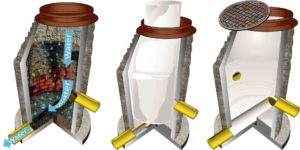 Alternative Lining Technologies (ALT) announces Ace Pipe Cleaning, a subsidiary of Carylon Corporation, as a certified installer of their cured-in-place manhole lining systems throughout the Central United States. Based out of Kansas City, MO, Ace Pipe Cleaning is one of the oldest and largest sewer contractors in the country. While their services and expertise are varied, they focus on sewer cleaning, inspection, and rehabilitation.
Alternative Lining Technologies (ALT) announces Ace Pipe Cleaning, a subsidiary of Carylon Corporation, as a certified installer of their cured-in-place manhole lining systems throughout the Central United States. Based out of Kansas City, MO, Ace Pipe Cleaning is one of the oldest and largest sewer contractors in the country. While their services and expertise are varied, they focus on sewer cleaning, inspection, and rehabilitation.
For 20 years Ace Pipe Cleaning has been the premier contractor for these services in Missouri, Kansas, Oklahoma, Texas, and Arkansas. During that time, they have maintained expertise in a rapidly advancing industry. Aging infrastructure and growing communities have forced the sewer industry to innovate products and technology that seek to maintain collection systems more efficiently. Trenchless technologies, like CIPP, have revolutionized the way communities approach rehab and the associated costs. Similarly, ALT is partnering with contractors, like Ace, to introduce a unique system for rehabilitating manholes and other vertical sewer structures.
Based on the concept of cured-in-place pipe, CIPM liners utilize coated felt and fiberglass combined with epoxy to rehabilitate structures, while stopping I/I and preventing further corrosion. The AltLiner is constructed of panels of felt, which are coated with PVC. These panels are thermally fused to form a sealed liner, custom made for each structure. Fiberglass panels are added for the structural component. The liner is then wet-out onsite and cured under steam and air pressure to conform the liner to the manhole. This creates a strong, corrosion resistant rim-to-invert liner that extends structure life by 50 years or more. Every liner is backed with a 20-year non-prorated warranty.
Alternative Lining Technologies is excited to partner with such a capable and reputable company, like Ace. ALT General Manager, Jim Rouse stated “We believe our system is the best solution for the immense corrosion problem in manholes and pump stations. We are focused partnering with respected installers, like Ace, to prove the value of the system to engineers and
collection systems.” Ace Pipe Cleaning executive, Steve Hontz, echoed Jim’s enthusiasm saying “This is a great solution for structural and hydrogen sulfide protection.”
Ace and ALT are planning demos and presentations in Missouri and Texas this summer to educate the industry about CIPM lining systems. If you’d like more information or to request a
presentation for your organization, contact Bryan Dobson at Ace Pipe Cleaning by calling 800-325-9372.
Blog, Industry News
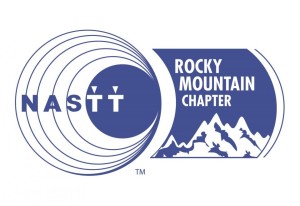 Trenchless Elevated 2017
Trenchless Elevated 2017
Rocky Mountain Chapter of North American Society for Trenchless Technology (NASTT)
7th Annual Regional Conference
CALL FOR ABSTRACTS
ABSTRACTS MUST BE SUBMITTED ELECTRONICALLY BY JUNE 15, 2017
PAPER TOPICS:
The Rocky Mountain Chapter of NASTT (RMNASTT) is now accepting abstracts for its 2017 regional conference in Denver, CO just north of the Bronco’s Stadium at The Denver PPA Center on November 8, 2017. Prospective authors are invited to submit an abstract and presentation proposal outlining the scope of their paper and the principal points of benefit to the trenchless industry. A variety of trenchless topics will be covered at the conference, and abstracts from the following subject areas are of interest to the selection committee. Case studies are encouraged.
- PIPELINE REHABILITATION FOR WATER, WASTEWATER & STORM WATER SYSTEMS
- ADVANCED PIPELINE CONDITION ASSESSMENT, INSPECTION
- PIPE BURSTING, HORIZONTAL DIRECTIONAL DRILLING (HDD), LATERAL LINING
- NEW INSTALLATIONS – TUNNELING, MICROTUNNELING, HDD, PIPE RAMMING
- TRENCHLESS RESEARCH, EMERGING TECHNOLOGIES, INDUSTRY ISSUES
SUBMITTAL DETAILS:
Abstract submissions are due by June 15, 2017. On your presentation proposal, please provide author/co-author contact information, presenter contact information, title of paper/ presentation, a brief description of the topic, and your abstract of approx. 150 – 250 words in Word format. For accepted abstracts, a technical paper will be required (1,500 words or less), and will include publication in the conference magazine. A 20-25 minute Powerpoint presentation will take place at the conference. If you are interested in participating, please e-mail your completed abstract, presentation proposal, and contact information to Swirvine Nyirenda snyirend@auroragov.org. Final papers and presentations will be due August 15, 2017.
ABOUT RMNASTT:
RMNASTT is a non-profit organization formed in 2009 to serve as a regional chapter of NASTT. The Rocky Mountain Chapter promotes education and implementation of trenchless technology throughout Colorado, Utah, Montana and Wyoming. The Chapter’s goal is to increase education and awareness of tunneling and trenchless technologies for pipeline rehabilitation and new construction applications. The RMNASTT annual conference and short course are valuable educational and networking events for public officials, engineers, utility company personnel, designers, consultants and contractors who are involved or interested in the construction, rehabilitation, and management of underground utilities.
QUESTIONS?
Benny Siljenberg, 303.625.9502| Benny@LithosEng.com or Joe Lane, 303.619.5060 | jlane@lanecg.com
Blog, Industry News, trenchless projects
Rebuilt TBM Will Bore in La Ciotat, France to Improve Access to Water Supply
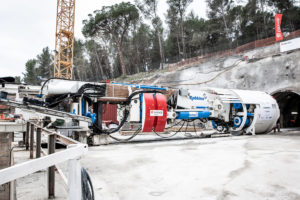 A Robbins TBM, recently christened “Augustine”, is being commissioned to undertake its eighth bore after being launched by contractor Eiffage Civil Engineering on March 3. The TBM, which was extensively modernized and upgraded during the rebuild for the Galerie des Janots project in La Ciotat, France, has previously completed seven other successful projects across Europe and Hong Kong. This time, it will bore the Janots gallery to improve access to water in the communities east of the Aix-Marseille-Provence metropolis (Cassis, Roquefort-la-Bédoule, La Ciotat and Ceyreste). “It’s a single machine 3.5 meters (11.5 ft) in diameter, 250 metric tons (275 US tons), and 135 meters (443 ft) long, that will work 24 hours a day for almost 10 months during this operation,” says Marc Dhiersat, Project Director of Galerie des Janots for Eiffage.
A Robbins TBM, recently christened “Augustine”, is being commissioned to undertake its eighth bore after being launched by contractor Eiffage Civil Engineering on March 3. The TBM, which was extensively modernized and upgraded during the rebuild for the Galerie des Janots project in La Ciotat, France, has previously completed seven other successful projects across Europe and Hong Kong. This time, it will bore the Janots gallery to improve access to water in the communities east of the Aix-Marseille-Provence metropolis (Cassis, Roquefort-la-Bédoule, La Ciotat and Ceyreste). “It’s a single machine 3.5 meters (11.5 ft) in diameter, 250 metric tons (275 US tons), and 135 meters (443 ft) long, that will work 24 hours a day for almost 10 months during this operation,” says Marc Dhiersat, Project Director of Galerie des Janots for Eiffage.
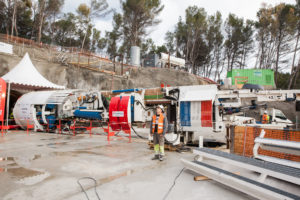 Currently, the machine is ramping up as back-up decks are being installed. As of April 2017, the machine has bored more than 51 m (167 ft), mainly encountering limestone. “Limestone is a rock easy to dig, but one can be confronted with the phenomenon of karst,” explains Loïc Thévenot, Director of Underground Works for Eiffage. “For this purpose, the tunnel boring machine is equipped with a probe drill. If the karst is small, we will fill it with concrete. If it is large, we will erect a small parallel gallery.”
Currently, the machine is ramping up as back-up decks are being installed. As of April 2017, the machine has bored more than 51 m (167 ft), mainly encountering limestone. “Limestone is a rock easy to dig, but one can be confronted with the phenomenon of karst,” explains Loïc Thévenot, Director of Underground Works for Eiffage. “For this purpose, the tunnel boring machine is equipped with a probe drill. If the karst is small, we will fill it with concrete. If it is large, we will erect a small parallel gallery.”
Galerie des Janots is one of the fourteen operations designed to save water and protect resources, which are being carried out by the Aix-Marseille-Provence metropolis, water agency Rhône Mediterranean Corsica, and the State Government. The future Janots gallery will replace existing pipelines currently located in the railway tunnel that have significant safety and vulnerability deficiencies with estimated water losses of 500,000 cubic meters (132 million gallons) per year. According to Danielle Milon, Mayor of Cassis, “This is an investment of 55 million euros (USD $59 million) with 11 million in aid from the water agency. This project required 10 years of reflection and work to improve water supply. And water is essential for the development of each municipality, and for citizens’ well-being.”
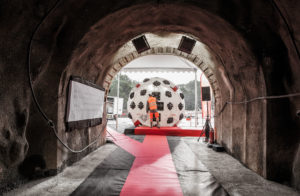 Augustine is boring a tunnel 2,750 m (1.7 mi) long, and will pass under Le Parc National des Calanques, with cover between 15 and 180 meters (50 to 600 ft), in order to replace the pipes that are currently being utilized for the water supply networks. “[The current pipes] have a capacity of transit limited to 330 liters (87 gallons) per second, which is largely insufficient in the summer period. The objective of the operation is to increase to 440 liters (116 gallons) per second,” says Dhiersat. Once the project is complete, networks can easily be maintained in comparison to the old pipes currently running beneath the railway.
Augustine is boring a tunnel 2,750 m (1.7 mi) long, and will pass under Le Parc National des Calanques, with cover between 15 and 180 meters (50 to 600 ft), in order to replace the pipes that are currently being utilized for the water supply networks. “[The current pipes] have a capacity of transit limited to 330 liters (87 gallons) per second, which is largely insufficient in the summer period. The objective of the operation is to increase to 440 liters (116 gallons) per second,” says Dhiersat. Once the project is complete, networks can easily be maintained in comparison to the old pipes currently running beneath the railway.
 Image 1: The 3.5 m (11.5 ft) diameter Robbins Main Beam TBM is boring its eighth tunnel in La Ciotat, France.
Image 1: The 3.5 m (11.5 ft) diameter Robbins Main Beam TBM is boring its eighth tunnel in La Ciotat, France.
Image 2: The Robbins TBM is excavating limestone rock with possible karst cavities for the 2.75 km (1.70 mi) Galerie des Janots Project.
Image 3: Contractor Eiffage Civil Engineering is operating the Robbins TBM, which is ramping up production having bored more than 51 m (167 ft) since March.
Image 4: The Galerie des Janots project will upgrade currently overtaxed water supply lines serving several communities east of France’s Aix-Marseille-Provence metropolis.
Blog, Industry News
 Early Bird registrations are now open for ASTT’s No-Dig Down Under 2017. Click here to register. Purchase your full conference registration now and receive AU$200 off till 14 July 2017.
Early Bird registrations are now open for ASTT’s No-Dig Down Under 2017. Click here to register. Purchase your full conference registration now and receive AU$200 off till 14 July 2017.
Nominations are open for the ASTT Awards, winners will be announced at the Official Gala Dinner sponsored by Ditch Witch Australia on Thursday 14 September 2017.
The ASTT Awards recognise excellence, innovation and outstanding achievement in Australia and New Zealand’s Trenchless Technology industry. Nominating your project or colleague will give you and your company international recognition by highlighting your achievement to key-stakeholders in the trenchless industry.
There are five categories available to ASTT members to nominate for. Submit a nomination here before they close on Thursday 1 June 2017.
Project of the year – Rehabilitation
Recognising innovation, advancements in technology, environmental benefits and occupational health and safety benefits in rehabilitation projects utilising Trenchless Technology.
Project of the year – New Installation
Recognising innovation, advancements in technology, environmental benefits and occupational health and safety benefits in new installation projects utilising Trenchless Technology.
New Technology – Machine, tool, material, system or technique
New Technology should demonstrate a practical development of trenchless systems or equipment that results in benefits such as improved economy, accuracy, speed of drive or replacement, ability to overcome difficult installations, or similar.
Person of the Year
The award recognises a contribution over and above the call of duty to grow, develop and promote the use of Trenchless Technology across Australasia and indeed around the world.
Young Person of the Year
Someone who is engaged with the industry and the promotion of Trenchless Technology, has significantly contributed to the industry over the past year, and is aged 40 or under on 1 September 2017.
For more information visit the www.nodigdownunder.com
Email or call conferences@gs-press.com.au or +61 3 9248 5100 for any additional questions.
 Truck vacs offer power, scalable tank capacity and reliability for high-production contractors
Truck vacs offer power, scalable tank capacity and reliability for high-production contractors “The new VXT truck series is designed for the production-minded utility contractor who is focused on maximizing uptime and maintaining a safe and productive jobsite,” said Jeff Wage, vice president at McLaughlin. “These machines fit that niche of being able to do the work that’s required at a price point high-production contractors can justify.”
“The new VXT truck series is designed for the production-minded utility contractor who is focused on maximizing uptime and maintaining a safe and productive jobsite,” said Jeff Wage, vice president at McLaughlin. “These machines fit that niche of being able to do the work that’s required at a price point high-production contractors can justify.” The VXT Series is powered by the industry-proven OMSI Gearbox and a ROOTS 3200 CFM (91 m3/min) blower. When the truck is put into PTO mode, the rear axle is disengaged and the OMSI gearbox becomes live to drive the ROOTS blower at 18 inches of mercury and 3200 cfm. The OMSI gearbox hydraulically provides the power to drive the 10 gpm/3,000 psi water pump as well.
The VXT Series is powered by the industry-proven OMSI Gearbox and a ROOTS 3200 CFM (91 m3/min) blower. When the truck is put into PTO mode, the rear axle is disengaged and the OMSI gearbox becomes live to drive the ROOTS blower at 18 inches of mercury and 3200 cfm. The OMSI gearbox hydraulically provides the power to drive the 10 gpm/3,000 psi water pump as well.









